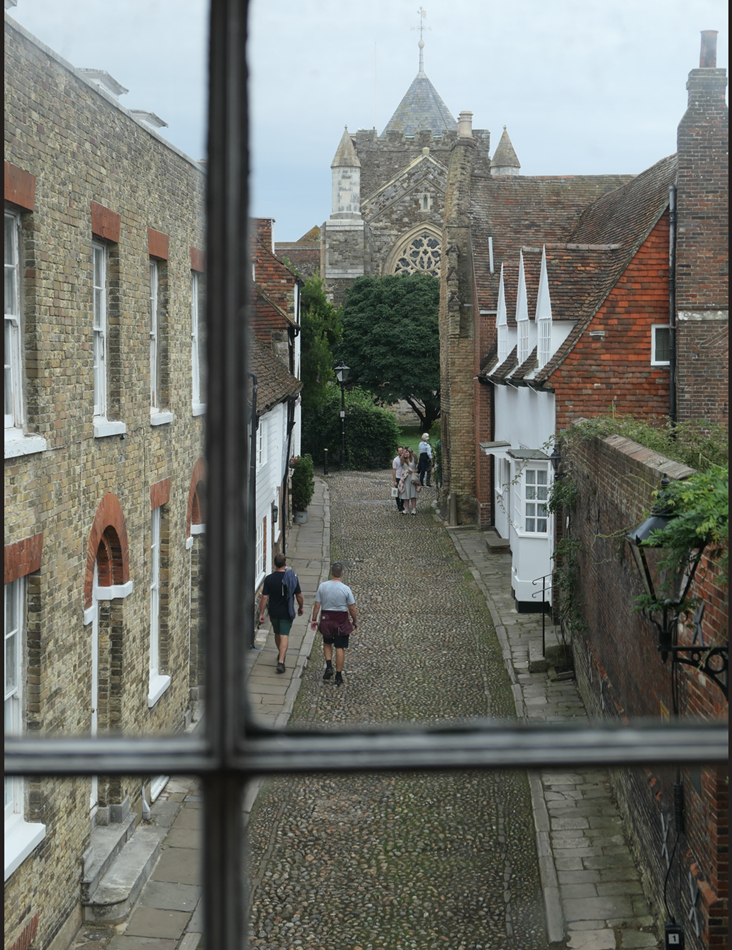It’s always a pleasure to look at towns with Pevsner (The
Buildings of England) in hand. For this trip, I used the original edition of Sussex,
dating back to 1965. Today, of course, the series has greatly expanded and the feel
of Pevsner has been greatly diluted. I don’t have the latest volume of Sussex
for comparison, but I would guess that the text is at least 50% longer, and the
text coverage much more comprehensive. But it is not only that the later
editions have more text. As Pevsner explains in the Foreword, he only did East
Sussex, while Ian Nairn wrote West Sussex, which enables the reader to compare
the two approaches. In an interesting comment, Pevsner writes: “Mr Nairn has a
greater sensibility to landscape and townscapes than I have, and he writes
better than I could ever hope to write. On the other hand, those who want
something a little more cataloguey and are fervently interested in mouldings
and such-like details, may find my descriptions more to their liking.”
Well, Pevsner covers the Rye in around 1,400 words (three
and a half pages). This is amazingly concise. The perambulation of the town omits
many buildings that in the later edition would certainly have a mention, not
just the more recent buildings. Most intriguing is where Pevsner pauses, to see
the workings of his mind when he spots something that interests him. Generally,
Rye is covered with simple brief mentions, although he notices the widespread Rye
checkerboard pattern of red and black bricks. He only really pays attention to three
buildings in the whole town, apart from the church: the Town Hall, the old
Grammar School, and the Old Hospital.
While for the most part he records dates and styles of buildings, no doubt following the working notes prepared from him by his dutiful, but not necessarily inspired, assistants in advance of the perambulation, for these three buildings he seems to come to life. It is certainly dating and detail that fascinates him.
 |
The Old Grammar School |
For the Old Grammar School, he is intrigued by the use of brick for giant pilasters and Dutch gables. He immediately runs through a checklist of early uses of each motif, and satisfies himself that here they are “remarkably early”. For the church, as usual, the focus is on dating as well. The transepts are “still essentially Norman”. In the South transept (sorry, S transept) “slightly post-Norman (dogtooth) bits have been reset.” It feels almost as if he was too frightened to relax from his academic dates and styles focus to let go and respond to the surroundings – for pretty much everything else in Rye, we get just the date and a few words about notable features.
You cannot help feeling that the essence of Rye hasn’t been captured. Rye, which was full
of visitors on the Friday and Saturday we visited, is one of the great exemplars
of a rural English town; but you feel somehow that Pevsner would never have
lived there; not enough issues of dating and precedence to engage him fully.
In contrast, Pevsner shows almost no interest in Lamb House,
one of the largest buildings in the town (“clearly of the early C18 with its
panelled parapet and its angle pilaster strips”). Of course, even if the
building is unmemorable, the situation is astonishing. The view from the living
room facing the church is right along West Street; you could not hope to have a
more central location in the old town. You can’t help feeling this must have
had an effect on Henry James’ writing. Why otherwise seek out this obscure
rural location and live there for 19 years?
Pevsner’s introduction is sketchy and raises as many
questions as it answers: “The E part of the town has largely disappeared, owing
to the action of the sea”, yet the town “started to diminish in the second half
of the C16, when the harbour silted up”. For him, the two themes of Rye are the
brick, already mentioned, and “the open view to the plain”. Actually, for a
hill town, there is not much of a view to the plain. There will be a view from
most of the private gardens facing S or W, but the only large-scale public view
in Rye is to the E. For example, I was not able to make out Camber Castle,
about a mile to the W, when looking from the old town.
In contrast, Nairn is highly aware of the surroundings,
whether positive (“Up Waltham … a wonderful group in a download valley … from
the S, church, farm and barns look like a monogram in flint”) or negative:
“Southwick … A bit of everything and not quite anything … The genus loci
seems to have gone on strike, or to have been locked out.” As the man himself
states, Pevsner feels his primary role is to establish those dates: which giant
order of pilasters came first, Rye, Kew, or Blickling? And I have to say, I’m
not really that bothered. I'd be more interested to know what Rye represents to all those day trippers.





No comments:
Post a Comment